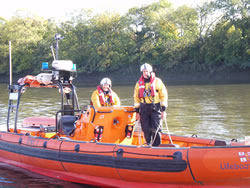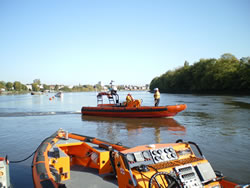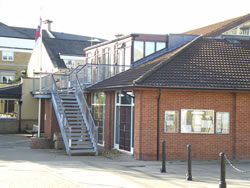Emma Brophy meets the men of Chiswick’s RNLI crew
|
How can an architect, a pilot, a property developer and a flight attendant all do the same job? Simple really, they spend their spare time volunteering as lifeboat crew as I discovered when I went to visit the Chiswick station.
Chiswick is one of four lifeboat stations on the Thames which became operational in January 2002, providing a round-the-clock rapid response service for the capital following the Thames Safety Inquiries into The Marchioness disaster which took 51 lives.
The Chiswick station has responsibility for the stretch of the tidal Thames from Richmond Lock to Chelsea Bridge and is manned by both full time RNLI staff and volunteers. “We have ten full time staff working four 12-hour shifts a week,” says Glen “We alternate night and day shifts that way with have a 24 hour seven day a week watch.”
Chiswick currently has 45 volunteers of whom two are women (the crew were keen for me to say that they would like to attract more female volunteers!). Because of their shift patterns and having a base on the Thames, volunteers do not have to live close to the river. “We’re pretty unique in that way. People historically lived near the river because it was their livelihood; it’s not like that anymore.” Says Glen looking out over Corney Reach, I take his point.
In terms of the number of people rescued, Chiswick is the busiest station and the team are quite rightly proud of their achievements. So far this year they have received 133 calls and rescued 38 people.
“It’s mainly rowers and their coaches from launches,” says Dave who is sitting next to me in half zipped into his all in one dry suit. Not the most attractive garment it has to be said but the crew needs to be able to launch the lifeboat within two minutes of taking a call so needs must! “Around 25-30% of the calls we get are jump threats and the rest are a bit of everything including dogs, people sitting or walking along the river walls and fall in.”
“Boat race day is a busy day; the wash [wave that comes after the flotilla of boats following the two crews] catches people unawares and takes them into the river. Last boat race day the wash went over the wall at Hammersmith and would have taken a crowd with it had the weather not been so awful, not many out that day!”
“The last Head of River Race we plucked 45 people from the river. On big races there are between 4,000-5,000 extra people on the river. On a normal day 100,000 people use the river.”
“People say to us ‘it’s just a river’ but it’s not,” says Carl. “It’s tidal; the water is a very powerful thing.”
Glen adds, “It’s fresh water or brackish water it’s sometimes called and it’s cold. There’s no buoyancy, it’s not like the sea. If you stop kicking, you go under. It’s not just a river.”
The RNLI receive no government funding and rely solely on voluntary contributions They regularly organize fund raising days of which their biggest – SOS - is on Friday 30 January. “It's a great way for everyone to have some fun, whilst raising funds to help the RNLI's volunteer lifeboat crews and lifeguards save lives on the river and at sea. Whether you get people Sample Our Snacks, Sponsor Our Sports or something completely different, you'll be helping the RNLI to rescue 21 people every day.”
The Chiswick station also has smaller fundraising events which somehow I found myself roped into, could have been my suggestion of a pub crawl! Details to follow.
Emma Brophy
October 24, 2008


